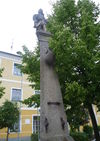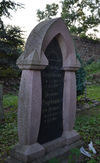Template:Generic:Map Features:historic
Historic
This is used to describe various historic places. For example: archeological sites, wrecks, ruins, castles and ancient buildings. See the page titled Historic for an introduction on its usage.
| Key | Value | Element | Comment | Rendering | Photo |
|---|---|---|---|---|---|
| historic | aircraft | A decommissioned aircraft which generally remains in one place | |||
| historic | aqueduct | A historic structure to convey water | |||
| historic | archaeological_site | A place in which evidence of past activity is preserved | |||
| historic | battlefield | The site of a battle or military skirmish in the past. This could be on land or at sea. | |||
| historic | bomb_crater | A bomb crater. | |||
| historic | building | If it's not clear what type a historic building has, it can be tagged as a generic building. | |||
| historic | cannon | A historic/retired cannon. Usually found at on forts or battlefields. | |||
| historic | castle | Castles are (often fortified) buildings from medieval and modern times. Other languages | |||
| historic | castle_wall | A |
|||
| historic | charcoal_pile | Historic site of a charcoal pile. Often still in good condition in hilly forest areas. | |||
| historic | church | A building with historical value for Christian religious activities, particularly for worship services. | |||
| historic | city_gate | A |
|||
| historic | citywalls | A |
|||
| historic | farm | A historical farm, kept in its original state. | |||
| historic | fort | A military fort – distinct from a castle as it is generally more modern | |||
| historic | gallows | A structure designed for capital punishment by hanging. | |||
| historic | highwater_mark | A marker for indicating past flood. | |||
| historic | locomotive | A decommissioned locomotive which generally remains in one place. | |||
| historic | manor | Historic |
|||
| historic | memorial | Much like a monument, but smaller. Might range from a WWII memorial to a simple plate on a wall. | |||
| historic | mine | Abandoned underground mine workings for minerals such as coal or lead. | |||
| historic | minecart | A cart used to transport coal or ore from a mine. | |||
| historic | mine_shaft | Vertical shafts of a historic mine | |||
| historic | milestone | A historic marker that shows the distance to important destinations. | |||
| historic | monastery | An historic monastery. See Also amenity=monastery. | |||
| historic | monument | A memorial object, which is especially large (one can go inside, walk on or through it) or high enough (see the examples), built to remember, show respect to a person or group of people or to commemorate an event. Other languages | |||
| historic | optical_telegraph | Historic optical telegraph | |||
| historic | pillory | A construction designed to immobilitate and humiliate a person who was convicted in lower courts. | |||
| historic | railway_car | A decommissioned railway car which generally remains in one place. | |||
| historic | ruins | Remains of structures that were once complete, but have fallen into partial or complete disrepair. If the type of original structure is known or apparent it can be described using ruins=*, e.g. ruins=castle. Alternative tagging is historic=castle, ruins=yes. |
|||
| historic | rune_stone | A |
|||
| historic | ship | A decommissioned ship or submarine | |||
| historic | stone | A stone shaped or placed by man with historical value. | |||
| historic | tank | A decommissioned tank which generally remains in one place. | |||
| historic | tomb | Historic tomb | |||
| historic | tower | Historic tower | |||
| historic | |||||
| historic | vehicle | A decommissioned land-based vehicle which generally remains in one place | |||
| historic | wayside_cross | A historical (usually christian) cross. Frequently found along the way in Southern Germany, Austria and probably elsewhere. | |||
| historic | wayside_shrine | A historical shrine often showing a religious depiction. Frequently found along the way in Southern Germany, Austria and probably elsewhere. | |||
| historic | wreck | Nautical craft that has unintentionally been sunk or destroyed. | |||
| historic | yes | Used to add the historic significance of the objects described by other tags. | |||
| historic | user defined | All commonly used values according to Taginfo |
This table is a wiki template with a default description in English. Editable here.
Note to editors: Please don't categorize this template by editing it directly. Instead, place the category in its documentation page, in its "includeonly" section.
Template for the Historic table in the Map Features page. Use the default English text or use the template arguments for your translations
Usage
All parameters are optional. By default, text is in English. English writers shall write their comments in the template itself (avoiding double edition). Other languages are translated in template arguments, not in the template itself.
== section header == |name= (section header line) |description= (displayed before and/or after the table; optional) == One key/value row == |historic:key= |ruins:value= |ruins:desc= |ruins:render= |ruins:photo=
Template for copy/paste...
<noinclude>{{Languages|ns=Template:|Map_Features:historic}}</noinclude>
{{Map_Features:historic
|name=
|description=
|head:key=
|head:value=
|head:element=
|head:desc=
|head:render=
|head:photo=
|archaeological_site:desc=
|battlefield:desc=
|boundary_stone:desc=
|castle:desc=
|manor:desc=
|memorial:desc=
|monument:desc=
|optical_telegraph:desc=
|ruins:desc=
|wayside_cross:desc=
|wayside_shrine:desc=
|wreck:desc=
|yes:desc=
|Proposed_features:value2=
|Proposed_features:desc=
}}







































